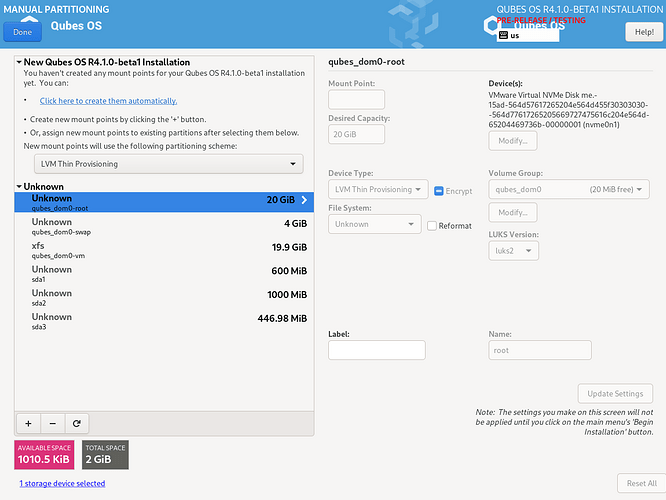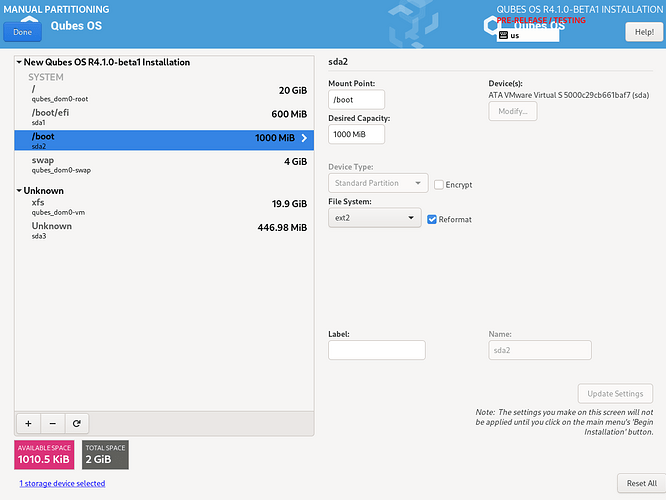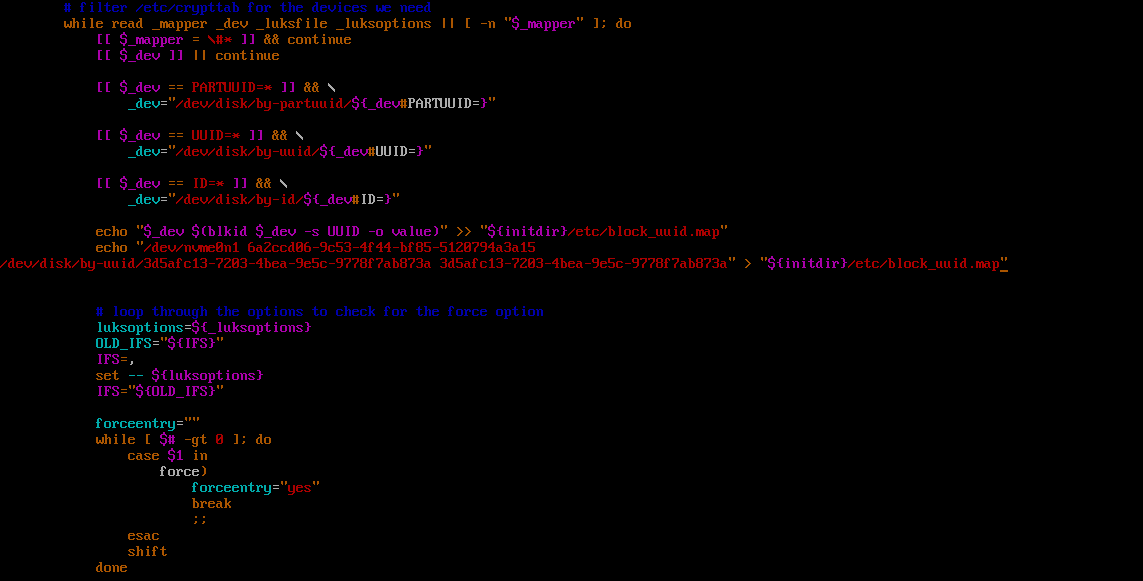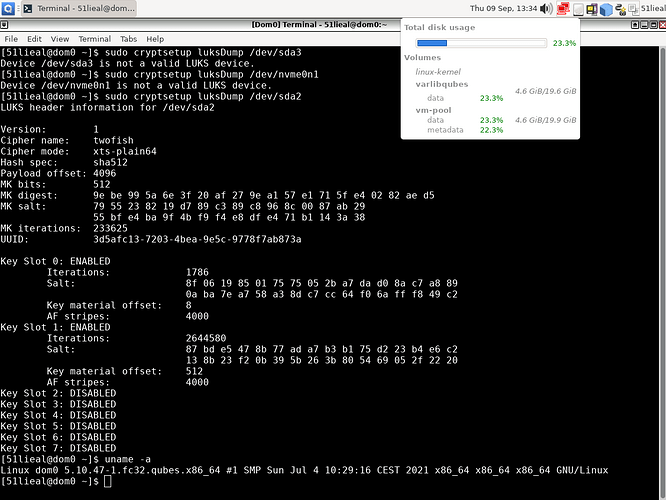Used device in testing and confirm is worked :
windows vmware (host using old pc) and my laptop.
both are using uefi.
Keep in mind that below are disk i used in the tutorial, you can use 2 flashdrive (1 boot, 1 header) + 1 hdd or whatever you want.
/dev/nvme0n1 = system
/dev/sda = flashdrive
Please watch out any space, slash, periode in command issue / files IT REALLY MATTER
- After booting into installation in language section, press ctrl + alt + f2
—# WARNING CONFIRM YOUR DISK FIRST BEFORE EXECUTING COMMAND
[anaconda /] dd if=/dev/urandom of=/dev/nvme0n1 bs=1M status=progress
[anaconda /] dd if=/dev/urandom of=/dev/sda bs=1M status=progress
Using /dev/urandom will take longer than /dev/zero but more secure.
- Create 3 partition in usb drive, just follow below command as i need the rest of space (i need around 20mb) for luks header.
[anaconda /] gdisk /dev/sda
---# efi partition
n
1
2048
1230845
EF00
---# boot partition
n
2
1230848
3278842
8300
---# header partition
n
3
(enter)
(enter)
(enter)
w
Y
—# I use iter time 1 for speeding up decrypt process you should increase it in real installation, see 5.13 for details.
[anaconda /] cryptsetup -c aes-xts-plain64 -h sha512 -s 512 -y -i 1 --use-random luksFormat /dev/nvme0n1
[luks prompt /] YES
[luks prompt /] (enter password)
[luks prompt /] (verify password)
[anaconda /] cryptsetup luksOpen /dev/nvme0n1 luks
[luks prompt /] (enter password)
[anaconda /] pvcreate /dev/mapper/luks
[anaconda /] vgcreate qubes_dom0 /dev/mapper/luks
[anaconda /] lvcreate -n swap -L 4G qubes_dom0
[anaconda /] lvcreate -T -L 20G qubes_dom0/root-pool
[anaconda /] lvcreate -T -l +100%FREE qubes_dom0/vm-pool
[anaconda /] lvs
—#
root-pool 20.00g
swap 4.00g
vm-pool 19.90g
—#
[anaconda /] lvcreate -V20G -T qubes_dom0/root-pool -n root
[anaconda /] lvcreate -V19.9G -T qubes_dom0/vm-pool -n vm
[anaconda /] mkfs.xfs /dev/qubes_dom0/vm
—# I use xfs because it much faster than ext4 when boot up, btw i dont do benchmark it’s just My Life Experience based on using qubes.
Otherwise :
[anaconda /] mkfs.ext4 /dev/qubes_dom0/vm
- Back to gui with ctrl + alt + f6.
- Choose language, timezone, user, and lastly storage.
- Click refresh on bottom right and rescan disk.
- Select disk nvme0n1 and sda, storage configuration is Custom.
—# reformat disk
qubes_dom0-root, reformat, ext4, /, update settings.
qubes-dom0-swap, reformat, swap, update settings.
sda1, reformat, Efi System Partition, /boot/efi, update settings.
sda2, reformat, ext2, /boot, update settings.
—# leave qubes_dom0-vm and sda3 untouched.
- Click done and begin installation.
- After completion, switch back to shell with ctrl + alt + f2
[anaconda /] cp -r /usr/lib/grub/x86_64-efi /mnt/sysroot/boot/efi/EFI/qubes/
[anaconda /] chroot /mnt/sysroot/
[anaconda /] mount -oremount,ro /boot
[anaconda /] install -m0600 /dev/null /tmp/boot.tar
[anaconda /] tar -C /boot --acls --xattrs --one-file-system -cf /tmp/boot.tar .
[anaconda /] umount /boot/efi
[anaconda /] umount /boot
[anaconda /] exit
—# WARNING CONFIRM YOUR DISK FIRST BEFORE EXECUTING COMMAND
[anaconda /] dd if=/dev/urandom of=/dev/sda2 bs=1M status=progress
[anaconda /] cryptsetup -c twofish-xts-plain64 -h sha512 -s 512 -y -i 1 --use-random --type luks1 luksFormat /dev/sda2
[luks prompt /] YES
[luks prompt /] (enter password)
[luks prompt /] (verify password)
—#
[anaconda /] uuidR="$(blkid -o value -s UUID /dev/nvme0n1)"
[anaconda /] uuidB="$(blkid -o value -s UUID /dev/sda2)"
[anaconda /] cryptsetup luksOpen /dev/sda2 luks-$uuidB
[anaconda /] mkfs.ext2 -m0 -U $uuidB /dev/mapper/luks-$uuidB
—#
[anaconda /] vi /mnt/sysroot/etc/fstab
—# Change UUID=…on boot line to /dev/mapper/luks-(your $uuidB) and leave the rest to default value
[anaconda /] chroot /mnt/sysroot
[anaconda /] mount -v /boot
[anaconda /] tar -C /boot --acls --xattrs -xf /tmp/boot.tar
[anaconda /] mount /dev/sda1 /boot/efi
[anaconda /] echo "GRUB_ENABLE_CRYPTODISK=y" >> /etc/default/grub
---# create luks keys so we dont have to enter any password after grub
[anaconda /] mkdir /etc/keys
[anaconda /] dd if=/dev/urandom bs=1 count=64 of=/etc/keys/root.key conv=excl,fsync
[anaconda /] dd if=/dev/urandom bs=1 count=64 of=/etc/keys/boot.key conv=excl,fsync
[anaconda /] cryptsetup luksAddKey /dev/nvme0n1 /etc/keys/root.key
[luks prompt /] (system password)
[anaconda /] cryptsetup luksAddKey /dev/sda2 /etc/keys/boot.key
[luks prompt /] (boot password)
[anaconda /] cryptsetup luksHeaderBackup /dev/nvme0n1 --header-backup-file header
---# WARNING CONFIRM YOUR DISK FIRST BEFORE EXECUTING COMMAND
[anaconda /] dd if=/header of=/dev/sda3 bs=16M count=1 status=progress
[anaconda /] exit
[anaconda /] echo "luks-$uuidB UUID=$uuidB /etc/keys/boot.key luks,key-slot=1" | tee -a /mnt/sysroot/etc/crypttab
[anaconda /] mount --bind /dev /mnt/sysroot/dev
[anaconda /] mount --bind /dev/pts /mnt/sysroot/dev/pts
[anaconda /] mount --bind /sys /mnt/sysroot/sys
[anaconda /] mount --bind /proc /mnt/sysroot/proc
---
[anaconda /] chroot /mnt/sysroot
[anaconda /] vi /etc/crypttab
---# Change root device value so it look like this

---
[anaconda /] vi /etc/dracut.conf.d/misc.conf
add_dracutmodules+=" crypt "
install_items+=" /etc/keys/root.key /etc/keys/boot.key /sbin/cryptsetup "
[anaconda /] vi /usr/lib/dracut/modules.d/90crypt/module-setup.sh
—# write a persistence device at /etc/block_uuid.map in generated initramfs
echo "/dev/nvme0n1 $uuidR
/dev/disk/by-uuid/$uuidB $uuidB" > "{initdir}/etc/block_uuid.map"
—# write a persistence device at /etc/crypttab in generated initramfs (we can’t inject /etc/crypttab files in dracut.conf)
echo "luks-$uuidR /dev/nvme0n1 /etc/keys/root.key luks,discard,key-slot=1,header=/dev/sda3
luks-$uuidB UUID=$uuidB /etc/keys/boot.key luks,key-slot=1" > $initdir/etc/crypttab
[anaconda /] grub2-mkconfig -o /boot/efi/EFI/qubes/grub.cfg
[anaconda /] dracut -v -f /boot/initramfs-*
[anaconda /] exit
[anaconda /] umount /mnt/sysroot/boot/efi
[anaconda /] umount /mnt/sysroot/boot
[anaconda /] umount -l /mnt/sysroot
[anaconda /] umount -l /mnt/sysimage
[anaconda /] swapoff /dev/qubes_dom0/swap
[anaconda /] vgchange -a n qubes_dom0
[anaconda /] cryptsetup luksClose /dev/mapper/luks
[anaconda /] cryptsetup luksClose /dev/mapper/luks-$uuidB
[anaconda /] cryptsetup luksErase /dev/nvme0n1
[luks prompt /] YES
[anaconda /] wipefs -a /dev/nvme0n1
[anaconda /] reboot
—# Screenshoot








 .
.